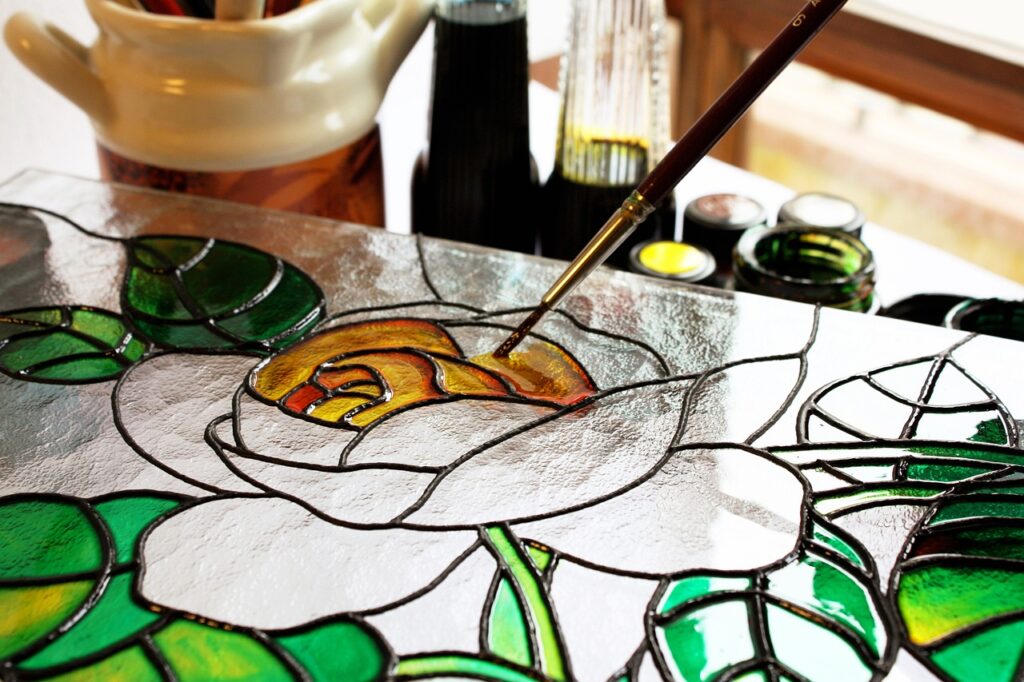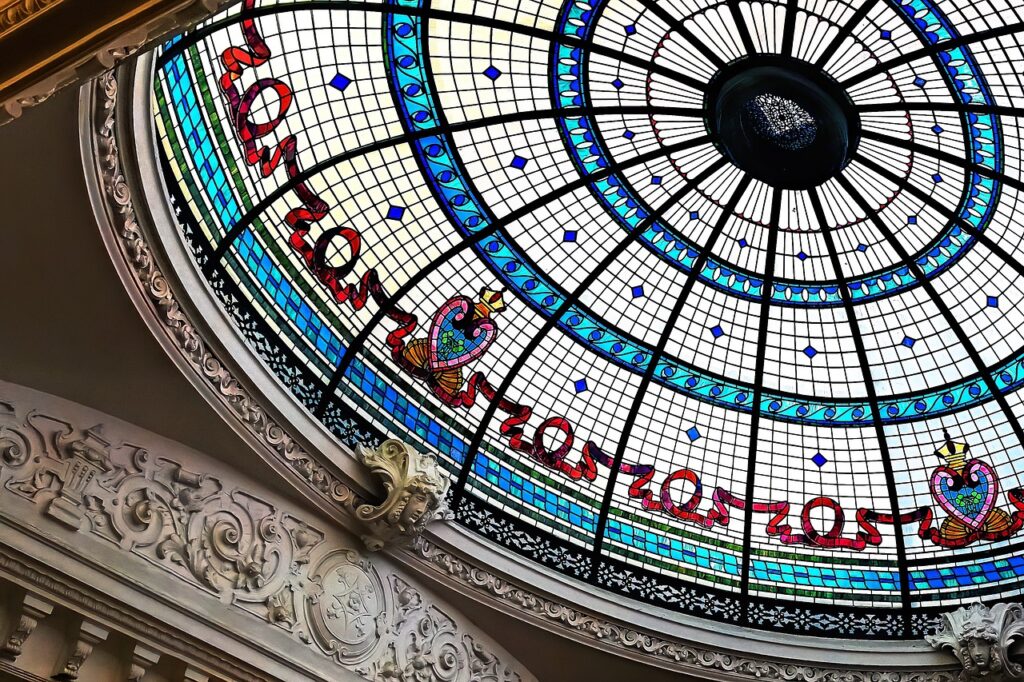Stained glass art is a form of visual art that involves the arrangement of colored glass pieces to create intricate and vibrant designs. This ancient craft has been practiced for centuries and is often associated with decorative windows found in religious buildings, such as cathedrals, churches, and mosques. However, stained glass art has also been used in secular architecture, as well as in various art pieces, lamps, and other decorative items.

The process of creating stained glass art typically involves the following steps:
1. Design: The artist first creates a design or pattern for the stained glass piece. This design can be inspired by various sources, including religious stories, nature, abstract concepts, and geometric patterns.
2. Glass Selection: Different types of colored glass are chosen to fit the design. The glass may be transparent, translucent, or opalescent, allowing light to pass through and create stunning visual effects.
3. Cutting: The selected glass is cut into various shapes using specialized tools, such as glass cutters and grinders. Each piece must fit precisely into the overall design.
4. Foiling or Leading: To assemble the individual glass pieces, they are wrapped with copper foil or encased in lead came (metal strips). These materials create a framework that holds the glass pieces together.
5. Soldering: Once the glass pieces are foiled or leaded, they are soldered together to create a sturdy and unified panel.
6. Finishing: The completed stained glass panel is cleaned, and additional finishing touches may be added, such as reinforcing the structure or adding patina to the solder lines.
Stained glass art is known for its beauty, rich colors, and ability to create stunning visual effects when illuminated by natural or artificial light. It has been used historically to tell stories, convey religious messages, and add a sense of awe and grandeur to sacred spaces. Today, stained glass art continues to be practiced by both traditional artisans and contemporary artists, and it remains a beloved and enduring art form appreciated by people worldwide.
Where did stained glass art originate?
Stained glass art has a long and fascinating history that dates back to ancient times. Its origins can be traced to several civilizations, but it gained significant prominence during the medieval period in Europe. Here’s a brief overview of its origin:
1. Ancient Origins: The concept of using colored glass to create decorative elements can be traced back to ancient civilizations such as the Egyptians, Greeks, and Romans. They used small pieces of colored glass to create intricate mosaics in windows and other decorative objects.
2. Romanesque Period: Stained glass art began to take shape in the early medieval period, around the 10th century. Initially, colored glass was mainly used in monasteries and churches, but the designs were relatively simple compared to later developments.
3. Gothic Period: The true flourishing of stained glass art occurred during the Gothic period, roughly from the 12th to the 16th century. Gothic architecture introduced larger and more elaborate windows with pointed arches and ribbed vaults. Stained glass windows became a central feature of cathedrals and religious buildings, and their designs became increasingly intricate and narrative-driven.
4. Rise of Religious Narratives: In the Gothic period, stained glass windows were not merely decorative elements but also served a didactic purpose. They depicted religious stories and biblical narratives to convey moral lessons and teachings to the largely illiterate population.
5. Technological Advancements: During the 12th and 13th centuries, significant technological advancements in glass production, such as the ability to create larger panes of glass and the use of lead strips for support, allowed for more complex and grandiose stained glass designs.
6. Renaissance and Beyond: With the arrival of the Renaissance in the 15th century, stained glass art saw some changes in style, influenced by the artistic trends of the time. However, the popularity of stained glass declined in the following centuries due to various factors, including religious and political changes and shifts in architectural styles.
7. Revival in the 19th Century: The 19th century witnessed a revival of interest in stained glass art, driven by the Gothic Revival movement and a renewed appreciation for medieval art and craftsmanship. This period saw the creation of both historical replicas and innovative new designs.
8. 20th and 21st Centuries: Stained glass art continued to evolve in the 20th and 21st centuries, with artists exploring new techniques, materials, and artistic expressions. While it remains an integral part of many historical buildings, it has also found its way into contemporary architecture and art installations.
Today, stained glass art is cherished for its historical significance, artistic beauty, and ability to add a touch of magic and awe to any space where it is displayed. Its rich history and timeless allure continue to captivate people around the world.
What are some famous stained glass artworks in history?
Throughout history, numerous stained glass artworks have gained fame for their exceptional beauty, craftsmanship, and historical significance. Here are some of the most famous stained glass masterpieces from different periods:
1. Chartres Cathedral Stained Glass (12th-13th century) – Chartres Cathedral in France is renowned for its stunning collection of medieval stained glass windows. The windows depict biblical stories, saints, and various religious scenes, and they are considered a prime example of early Gothic stained glass art.
2. Sainte-Chapelle Stained Glass (13th century) – Located in Paris, France, Sainte-Chapelle houses an exquisite collection of high Gothic stained glass. Its immense windows portray over a thousand scenes from the Bible, making it a remarkable artistic and religious treasure.
3. Rose Windows of Notre-Dame de Paris (13th century) – The Notre-Dame Cathedral in Paris features three famous rose windows, including the North Rose Window, South Rose Window, and West Rose Window. These large circular windows are adorned with intricate designs and biblical figures.
4. The Tree of Jesse, York Minster (15th century) – York Minster in England houses the “Tree of Jesse” stained glass window, which illustrates the genealogy of Christ, tracing his lineage back to Jesse, the father of King David.

5. The Windows of Canterbury Cathedral (12th-14th century) – Canterbury Cathedral in England has an impressive collection of stained glass windows, including the Ancestors of Christ and the Miracle Windows, which depict miracles associated with the saints.
6. The Five Sisters, York Minster (13th century) – Another masterpiece at York Minster, the “Five Sisters” window is a vast composition of beautiful geometric patterns and intricate designs.
7. Marc Chagall’s Stained Glass (20th century) – Renowned artist Marc Chagall created several impressive stained glass installations, including the Peace Window at the United Nations Headquarters in New York and the stained glass windows at the Fraumünster Church in Zurich, Switzerland.
8. The Blue Mosque (Sultan Ahmed Mosque) Stained Glass (17th century) – Located in Istanbul, Turkey, the Blue Mosque boasts stunning stained glass windows with intricate floral and geometric designs, reflecting the artistry of Ottoman craftsmanship.
9. Tiffany Studios’ Stained Glass Lamps (late 19th-early 20th century) – Tiffany Studios, led by Louis Comfort Tiffany, produced numerous exquisite stained glass lamps that are highly prized for their innovative designs and use of opalescent glass.
These are just a few examples of famous stained glass artworks that have left a lasting impact on art history and continue to inspire awe and admiration today. Each of these masterpieces showcases the artistic brilliance and technical skill of the craftsmen who brought them to life.
